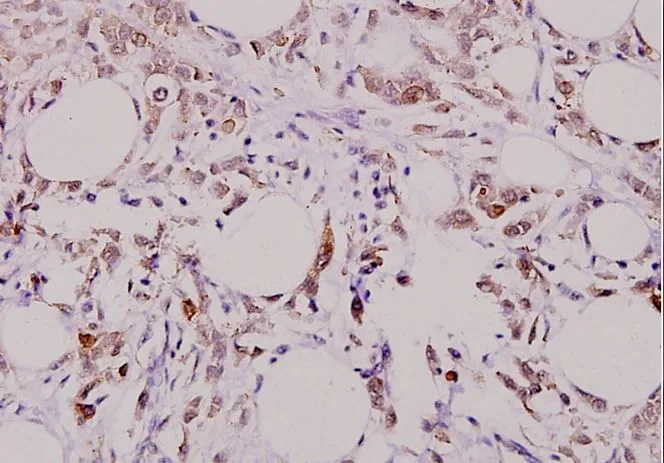
Immunohistochemistry (IHC) analyzes of Actived-Caspase-3 p17 pAb in paraffin-embedded human breast carcinoma tissue at 1:100.
Caspase 3 p17 subunit antibody
GTX49360
ApplicationsWestern Blot, ImmunoHistoChemistry, ImmunoHistoChemistry Paraffin
Product group Antibodies
ReactivityHuman
TargetCASP3
Overview
- SupplierGeneTex
- Product NameCaspase 3 p17 subunit antibody
- Delivery Days Customer9
- Antibody SpecificityActived-Caspase-3 p17 pAb detects endogenous levels of Actived-Caspase-3 p17 protein.
- Application Supplier NoteWB: 1:500 - 1:1000, IHC-P: 1:50 - 1:200
- ApplicationsWestern Blot, ImmunoHistoChemistry, ImmunoHistoChemistry Paraffin
- CertificationResearch Use Only
- ClonalityPolyclonal
- Concentration1 mg/ml
- ConjugateUnconjugated
- Gene ID836
- Target nameCASP3
- Target descriptioncaspase 3
- Target synonymsapopain; CASP-3; caspase 3, apoptosis-related cysteine peptidase; caspase 3, apoptosis-related cysteine protease; caspase-3; CPP32; CPP-32; CPP32B; cysteine protease CPP32; PARP cleavage protease; procaspase3; protein Yama; SCA-1; SREBP cleavage activity 1
- HostRabbit
- IsotypeIgG
- Protein IDP42574
- Protein NameCaspase-3
- Scientific DescriptionThe protein encoded by this gene is a cysteine-aspartic acid protease that plays a central role in the execution-phase of cell apoptosis. The encoded protein cleaves and inactivates poly(ADP-ribose) polymerase while it cleaves and activates sterol regulatory element binding proteins as well as caspases 6, 7, and 9. This protein itself is processed by caspases 8, 9, and 10. It is the predominant caspase involved in the cleavage of amyloid-beta 4A precursor protein, which is associated with neuronal death in Alzheimers disease. [provided by RefSeq, Aug 2017]
- ReactivityHuman
- Storage Instruction-20°C or -80°C,2°C to 8°C
- UNSPSC12352203

